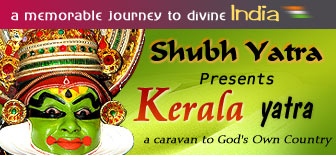 |
| India
Related Links |
Know
Kerala |
Experience
Kerala |
Kerala
Holiday Ideas |
Plan
Your Trip |
CLIMATE OF KERALAMajor Seasons : Summer, Monsoon,
Post-monsoon and Winters Climate : Tropical Temperature : Max 32 degree C, Min 20 degree C Best Time To Visit : August-April |
||

Swaying Palms During Kerala Monsoons
Truly speaking, nature shows its incomparable identities whenever it gets a chance. And in order to hold up its unquenchable thirst for beautification, it doesn't even spare God's own country. The land of Keralaputras or Keram (coconut trees) embraced by the evergreen Western Ghats on one side and the abysmal Arabian Sea on the other, is as different from the rest of India as diamond is to iron. It is this favourable geography which makes Kerala matchless. The monsoon winds, pinned above Kerala by the Western Ghats, are forced to release their precious content on this thin strip of land. The summers are not potent enough to precipitate frustration among the masses, but then there is Arabian Sea, to draft off all the tensions. Then there is winter, which calls for hundreds of migratory guests from as far as Siberia to roost in its green forests. In short, it is the climate that along with its attractions, have lured its guests from time immemorial and is still doing so with satisfactory results.
Kerala, lying majorly in the tropical region, apparently
experiences a humid tropical wet climate common to most of world's
rainforests. However, its extreme eastern fringes experience a drier
tropical climate, but not a continues dry spell as is in rest of India.
The summers onset in April and continues till June. Maximum temperature of
this coconut state rarely go beyond 32°C. But this is the season
whence most of the temple festivals are held and add quite a charm to the
much-dreamt holidays. Otherwise chill out at the hill tops of Munnar or
Wayanad amidst the mist-clad mountains and lush green tea gardens.
The south-west monsoons soon knocks the door by the end of June. The
season is often identified to a battalion of grey elephants. For
three-and-a-half months, Kerala receives the full brunt of the winds that
bring rain to the entire sub-continent. The tall palm trees flatten
themselves against the blitzkrieg like adept soldiers, but rarely break.
The red earth is churned into rivulets of blood. You will see every
individual, big or small, carrying an umbrella under the arm, unfurled
within seconds to create a colourful dragonline of jostling scales. The
hills of Kerala, too, have their own charm during the monsoons. Remember,
it is fascinating to see the nature when it is wet!
Once the rains have passd, the country swells up with a voluptous
luxuriance. The labyrinthine chain of canals, known as backwaters, formed
by linked up rivers turns the countryside into a sheet of glimmering
diamonds. People live a semi-aquatic life, bathing, washing, planting
rice, fishing, moving from one place to another on their flat-rice barges
or single-paddled canoes.
The chillness in the air continues till November which is then bolstered
with the beginning of winters, which continues until end of February. The
minimum temperature at sea level does not go below 20°C, so it is
always fun to plan a holiday tour during these months. The cool months
surely invite a range of migratory birds from all over the globe which can
be seen hovering over the surface of water. Visit the world famous Periyar
sanctuary in Kerala and you can see animals getting a tan! You can even
enjoy the warmth of the sun with a backwater cruise in Kerala.
|
Highlights of Climate of Kerala |
|
 Feel The Equable Weather The Memorable Monsoons The Serene Summers Welcome By Winters The Backless Beaches »
Glorious Kerala »
Southern Splendours »
Unforgettable
South & Beaches 
Lakshadweep 
Goa Beaches 
Tamil Nadu 
Pondicherry 
South India |